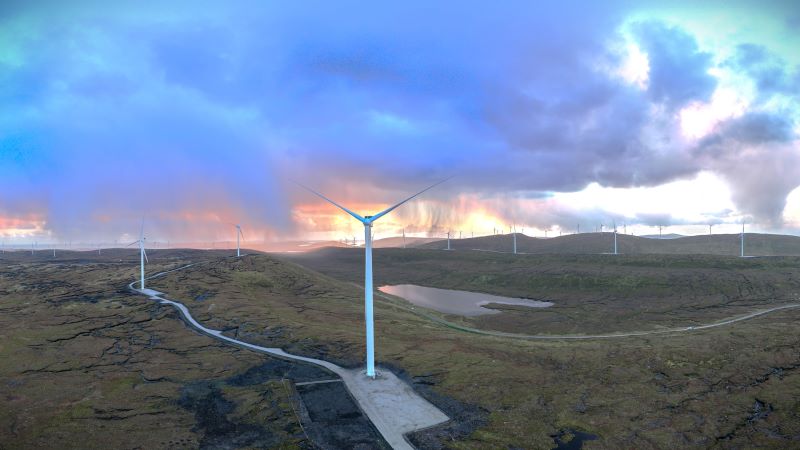Image credit: SSE Renewables
29/08/2024 | Offshore wind



UK wind power reaches historic 30GW milestone
29 August 2024 - RenewableUK press release
The UK has today hit a historic milestone of 30 gigawatts (30,000 megawatts) of wind generation capacity. The opening of SSE Renewables’ Viking Wind Farm on the Shetland Islands boosted the country’s capacity by 443MW, taking the total past the 30GW threshold.
Total operational capacity of combined onshore and offshore wind in the UK now stands at 30,299MW, as tracked by RenewableUK’s EnergyPulse, the industry’s market intelligence service. This is enough to meet the annual power needs of more than 26 million homes and cut carbon emissions by more than 35 million tonnes a year.
Renewables provided a record 46.4% of the UK’s electricity in 2023, according to the latest statistics published by the Government in July, with wind remaining our biggest source of clean power. Combined onshore and offshore wind power generated a record 28.1% of our total electricity last year, whilst accounting for more than 60% of electricity generated from renewable sources.
The UK’s first commercial onshore wind farm, Delabole in Cornwall, went operational in 1991, and the first offshore wind project off the coast of Blyth in the north east of England began generating in 2000. Initially, wind deployment climbed slowly to 1GW in 2005 and grew to 5GW in 2010, before expanding rapidly to 10GW in 2013 and 15GW in early 2017. Capacity has subsequently doubled in just seven years to reach the 30GW milestone.
Viking Wind Farm has been in development for around 15 years, at a cost of approximately £1.2bn in private investment, and will provide energy for households roughly equivalent to a city the size of Birmingham. Consisting of 103 turbines, it will harness Shetland’s exceptionally strong wind resource and will deliver renewable energy to the grid via a 260km High Voltage Direct Current (HVDC) subsea cable. Thanks to the unique wind conditions in Shetland, Viking will be the UK’s most productive onshore wind farm in terms of annual electricity output and will be capable of generating around 1.8 terawatt hours (TWh) of renewable electricity annually.
Commenting on the milestone, RenewableUK’s Executive Director of Policy & Engagement, Ana Musat, said:
“It took 26 years to install the first 15GW of wind energy in the UK, so to double that to 30GW in just seven years represents a tremendous success for the industry. As the latest record-breaking figures from the Government show, wind is the backbone of our future energy system and a key driver of our transition away from expensive and volatile fossil fuels to become a clean energy superpower.
“Our research also shows doubling the UK’s onshore wind capacity by the end of the decade would boost the economy by £45 billion and create 27,000 jobs, whilst moving to an electricity system dominated by offshore wind by 2035 would leave consumers around £68 a year better off.”
Stephen Wheeler, Managing Director of SSE Renewables, added:
“We’re thrilled the delivery of our Viking Wind Farm takes the UK’s wind power capacity past the 30GW mark. As the largest onshore wind farm to be built in the UK in nearly ten years, the completion of the project is a big moment in its own right – and contributing to this milestone for the industry makes it even more special. Viking will now play a major role in the UK’s net zero transition, harnessing Shetland’s unparalleled wind resource to become the country’s most productive onshore wind farm.
“Reaching 30GW is a great achievement, and SSE Renewables is proud to account for over 10% of that total across our onshore and offshore wind portfolio. It’s clear, however, that we need to go faster if we’re to have a chance of delivering a zero-carbon energy system by the end of this decade, and we stand ready to play our part in hitting many more milestones in years to come.”
(ends)
Notes
For further information, contact
Sam Sheppard, Senior Communications and Campaigns Manager
07738493827 Sam.Sheppard@RenewableUK.com
RenewableUK’s members are building our future energy system, powered by clean electricity. We bring them together to deliver that future faster; a future which is better for industry, billpayers, and the environment. We support over 470 member companies to ensure increasing amounts of renewable electricity are deployed across the UK and to access export markets all over the world. Our members are business leaders, technology innovators, and expert thinkers from right across industry.
RenewableUK’s EnergyPulse is the industry’s go-to market intelligence service for renewable energy news, project data and analysis. By connecting to our 490+ member network, we research the renewable energy market, sourcing industry news, renewable energy market size, project ownership and contracts. Interactive tools help you dig into the detail of project data for the information you need, covering comprehensive and accurate renewable energy data, insights, and dashboards for the onshore wind, marine, energy storage and green hydrogen sectors in the UK - and offshore wind globally.
Further details on the opening of Viking wind farm are available on the SSE Renewables website. For media enquiries, please contact media@sse.com
The city of Birmingham has 423,500 households, according to the latest census data from 2021.
Based on the projected total average generation output of ~1.8TWh per annum, in comparison with the leading UK operational and in construction wind farms, Viking Wind Farm stands as the UK’s most productive onshore wind farm.
RenewableUK’s Onshore Wind Prospectus shows that delivering 30GW of onshore wind by 2030 would add £45 billion to the economy and create 27,000 jobs.
Analysis by Aurora Energy Research demonstrates that the lowest cost electricity system which future governments could build by 2035 is one dominated by offshore wind. This is cheaper for billpayers than alternatives such gas (with or without carbon capture and storage), or importing power from abroad via interconnectors
.


